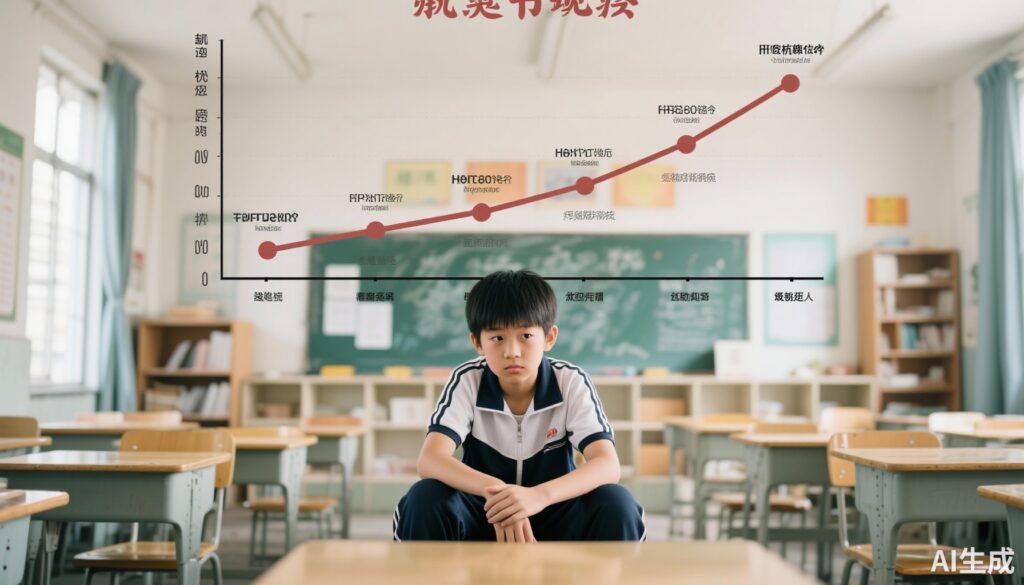Highlight
- Prevalence of depressive symptoms in early adolescents increased significantly over 12 months in a large Chinese cohort.
- Three distinct trajectories identified: consistently low-risk, persistently elevated high-risk, and steeply increasing progressing-risk groups.
- Female gender, left-behind status, family structure, sleep, screen time, and physical activity were significant predictors of high and progressing risk.
- Lower parental education uniquely associated with steeply increasing depressive symptom trajectory.
Study Background
Adolescence is a pivotal period for emotional and psychological development, marking heightened vulnerability to depressive disorders that can have long-lasting consequences. Globally, depression ranks among the leading causes of disease burden in adolescents, affecting academic performance, social functioning, and increasing risk for suicide. Despite this, knowledge about how depressive symptoms evolve during the transition from childhood to early adolescence remains limited, particularly within Chinese populations where sociocultural and familial environments differ from Western contexts. Identification of depressive symptom trajectories and their predictors is crucial for targeted prevention, timely intervention, and policy formulation tailored to regional needs.
Study Design
This prospective cohort study involved 2,635 junior middle school students from seventh and eighth grade in Nanchong, Sichuan Province, China, observed over a 12-month period from 2022 to 2023. Participants completed assessments of depressive symptoms at three waves spaced six months apart utilizing the validated Center for Epidemiologic Studies Depression Scale (CES-D). Essential sociodemographic data (e.g., gender, parental education, family structure, left-behind status) and behavioral factors (sleep duration, screen time, physical activity frequency) were collected via self-report.
Group-based trajectory modeling (GBTM) was applied to longitudinal CES-D scores to identify latent classes of depressive symptom patterns. Multinomial logistic regression analyses were performed to elucidate sociodemographic and behavioral predictors associated with membership in each trajectory class.
Key Findings
The study uncovered a rising trend in depressive symptom prevalence across the three assessment points: 13.40% at baseline, increasing to 21.56% at six months, and 26.94% at 12 months, underscoring the increases in adolescent mental health burden during early adolescence.
Three distinct depressive symptom trajectories emerged from GBTM analysis:
- Low-risk group (27.40%): Characterized by consistently low depressive symptoms throughout the study period.
- High-risk group (28.54%): Demonstrated persistently elevated depressive symptom levels, indicating stable high distress.
- Progressing-risk group (44.06%): Exhibited a steep increase in depressive symptoms over time, suggestive of escalating mental health risk.
Multinomial logistic regression identified several predictors significantly associated with the high-risk and progressing-risk trajectories:
- Female gender: Females had higher odds (adjusted odds ratio [aOR] range 1.4–3.2) of belonging to both high-risk and progressing-risk classes, consistent with well-documented gender disparities in adolescent depression.
- Left-behind status: Adolescents separated from parents due to rural labor migration also faced increased risk, reflecting the psychological impact of family disruption.
- Reconstituted family structure: Non-intact family environments were linked to greater depressive symptom burden.
- Behavioral factors: Shorter sleep duration, prolonged screen time, and low physical activity frequency predicted elevated and progressing depressive symptom trajectories, highlighting modifiable lifestyle contributors.
- Lower parental education: This factor was uniquely associated with the progressing-risk group (aOR=1.27, P<0.05), suggesting socioeconomic influences on trajectory acceleration.
Expert Commentary
This study provides valuable longitudinal insight into heterogeneous depressive symptom trajectories during a critical developmental window. The sizable sample and use of sophisticated trajectory modeling strengthen confidence in the findings. The identification of a large progressing-risk subgroup is particularly notable, suggesting many early adolescents experience worsening symptoms that may currently go unrecognized.
However, the observational window of only one year may underestimate longer-term trajectories and remission rates. Regional sampling in Nanchong limits generalizability to other parts of China and beyond, as cultural and socioeconomic factors vary widely. The reliance on self-reporting might introduce measurement bias, especially underreporting due to stigma. Additionally, unmeasured confounders such as comorbid anxiety or traumatic experiences could moderate trajectory membership.
Biological plausibility exists linking disrupted sleep and physical inactivity to depression via neuroendocrine and inflammatory pathways. Screen time likely affects emotional wellbeing through social isolation or exposure to harmful content. The heightened vulnerability of females aligns with hormonal and psychosocial risk models.
Clinical strategies should emphasize early screening for high-risk and progressing-risk adolescents, focusing on modifiable lifestyle factors alongside psychosocial supports. Given the disproportionate risk in left-behind children, interventions should address family cohesion and parental engagement even in migrant contexts.
Conclusion
This cohort study delineates three distinct developmental trajectories of depressive symptoms in early adolescence among Chinese school children, revealing a troubling increase in symptom prevalence and a large subset at risk of worsening depression. Sociodemographic factors such as gender, family structure, and parental education, coupled with behavioral influences like sleep, screen time, and physical activity, collectively shape these trajectories.
Early identification of at-risk adolescents through longitudinal monitoring and targeted intervention on modifiable risk factors holds promise to alleviate the mental health burden during this formative period. Future research should extend follow-up duration, broaden regional sampling, incorporate multi-informant assessments, and evaluate preventive intervention efficacy across identified trajectory groups.
Funding and Disclosure
Details of funding sources and clinical trial registration were not specified in the original study abstract. Transparency regarding funding and potential conflicts of interest should be sought from the original publication.
References
Chen P, Jiang P, Cui Y, Yuan X, Ren J, Gong J, Liao Y, Yuan L, Pan Q, Zhang H, Yang Q, Tian X. Developmental trajectories of depressive symptoms during early adolescence: A 12-month cohort study in Nanchong, China. J Affect Disord. 2025 Dec 15;391:119941. doi: 10.1016/j.jad.2025.119941. Epub 2025 Jul 19. PMID: 40691904.



